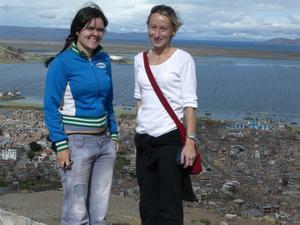Advertisement
Published: January 29th 2006

 Astrid and Aashild
Astrid and Aashild
Looking out over Puno and Lake Titicaca.Puno and Lake Titicaca
By guest authors Aashild Espedalen and Astrid Diana Oramas. In Arequipa Astrid and I left Robin and Helene behind to study Spanish and travelled on to
Puno by Lake Titicaca. The busride took around 6 hours and we arrived late in the afternoon. As Lake Titicaca lies at 3820 meters above sea level we soon noticed shortness of breath as we climbed the stairs in the hostel. We went to bed early to get ready for a big day ahead on the lake.
Lake Titicaca is the highest lake with passenger boat services in the world and is also South America’s largest lake and the largest lake in the world above 2000 m. Puno is a small port situated at the shore of Lake Titicaca. It is an excellent departure point for trips to the various islands of the lake, among these the unique Islas Flotantes (floating islands) of the Uros people and Isla Taquile.
Astrid and I left early next morning by boat to visit Islas Flotantes and Isla Taquile. The first stop was the
Islas Flotantes. These islands are built by using the totora reeds (siv) that grows in the shallows of

 Astrid
Astrid
Looking out over Puno and Lake Titicaca.the lake. The reeds are used to make the homes, the boats and the crafts of the Uros people. The reeds are constantly replenished from the top as they rot from the bottom. Initially the Uros began their existence centuries ago in an effort to isolate themselves from the Incas and the Spaniards. Today several hundreds of people still live on the islands where they even have a school, post office and a phone (see photo of Astrid and I by the public phone on one of the islands!). Today the Uros people live of fishing and tourism.
The next stop, a 3 hour boat trip further out on the lake, was
Isla Taquile. Isla Taquile is a real, 6 km long island with a population of about 2000 Quechua-speaking islanders. These people maintain a strong sense of group identity and live their lives without much influence from the modern mainland. After we arrived on the island we walked up to the village itself, it was a beautiful 1-hour hike. Along the way we came across men, women and children all knitting. Creations are made according to a system of social customs. For example, men knit themselves red hats
if they are married and red-and-white hats if they are single. Unfortunately we did not have enough time to stay over night at the island (this is highly recommended), so after lunch we headed back down the boat and got seriously sun-burned on the 4-hour trip back to Puno. Astrid was still peeling on her face one week later on the Inca-trail…
The photos are from Isla Taquile.
Advertisement
Tot: 0.058s; Tpl: 0.01s; cc: 10; qc: 19; dbt: 0.024s; 1; m:domysql w:travelblog (10.17.0.13); sld: 1;
; mem: 1mb

 Astrid and Aashild
Astrid and Aashild
 Astrid
Astrid
Brenda
non-member comment
We want to go to Peru
Thank you for the beautiful pictures! We felt as if we were there. Unfortunately we aren't so we will have to go! Blessings!